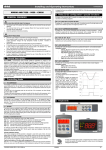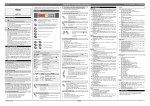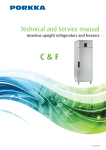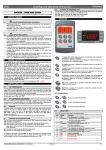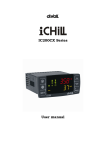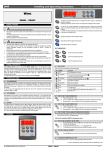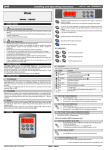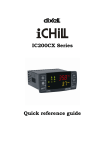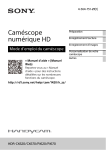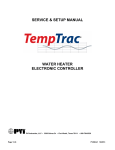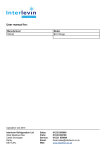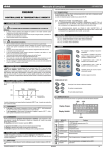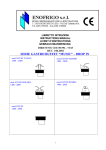Download dIXEL Installing and Operating Instructions
Transcript
Installing and Operating Instructions dIXEL XW60K AND T620 – V620 – CX620 1592026020 is stopped the fans go on working for the Fon time. With Fon =0 the fans remain always off, when the compressor is off. 4. Relay 22-23 configuration- special functions 1. GENERAL WARNING x x x PLEASE READ BEFORE USING THIS MANUAL This manual is part of the product and should be kept near the instrument for easy and quick reference. The instrument shall not be used for purposes different from those described hereunder. It cannot be used as a safety device. Check the application limits before proceeding. By means of the parameter oA3, it’s possible to configure the functions of the light relay (22-23), as described in the following paragraphs: OA3 = LIG: LIGHT RELAY (FACTORY SETTING) By setting oA3 = Lig the relay will work as light relay, it is switched on and off by the light button on the keyboard and is affected by status of the digital input when i1F = dor. OA3 = CP2 2ND COMPRESSOR MANAGEMENT By setting oA3 = cP2, the relay at terminals 22-23 will operate as “second compressor”. It will be activated in parallel with the relay of the first compressor, with a possible delay set in the AC1 parameter (seconds). Both the compressors are switched off at the same time. SAFETY PRECAUTIONS x x x x x x x x Check the supply voltage is correct before connecting the instrument. Do not expose to water or moisture: use the controller only within the operating limits avoiding sudden temperature changes with high atmospheric humidity to prevent formation of condensation Warning: disconnect all electrical connections before any kind of maintenance. Fit the probe where it is not accessible by the End User. The instrument must not be opened. In case of failure or faulty operation send the instrument back to the distributor or to “Dixell S.p.A.” (see address) with a detailed description of the fault. Consider the maximum current which can be applied to each relay (see Technical Data). Ensure that the wires for probes, loads and the power supply are separated and far enough from each other, without crossing or intertwining. In case of applications in industrial environments, the use of mains filters (our mod. FT1) in parallel with inductive loads could be useful. 2. General description Model XW60K is microprocessor based controller suitable for applications on medium or low temperature refrigerating units. It has to be connected by means of a two-wire cable ( 1mm) at a distance of up to 30 meters to the keyboard T620 or V620 or CX620. It is provided with four relay outputs to control compressor, defrost - which can be either electrical or hot gas - the evaporator fans and light. It is also provided with 4 NTC probe inputs, one for temperature control, one to control the defrost end temperature of the evaporator and the third and fourth to control condenser temperature or to display another temperature. The HOT KEY output allows to connect the unit, by means of the external module XJ485-CX, to a network line ModBUS-RTU compatible such as the dIXEL monitoring units of X-WEB family. It allows to program the controller by means the HOT KEY programming keyboard. The instrument is fully configurable through special parameters that can be easily programmed through the keyboard. 3. Controlling loads 3.1 THE COMPRESSOR The regulation is performed according to the temperature measured by the thermostat probe with a positive differential from the set point: if the temperature increases and reaches set point plus differential the compressor is started and then turned off when the temperature reaches the set point value again. In case of fault in the thermostat probe the start and stop of the compressor are timed through parameters “COn” and “COF”. The relay of the second compressor is activated in parallel with the relay of the first compressor, with a possible delay set in the AC1 parameter. Both the compressors are switched off at the same time. 3.2 FAST FREEZING When defrost is not in progress, it can be activated by holding the “o” key pressed for about 3 seconds. The compressor operates to maintain the “ccS” set point for the time set through the “CCt” parameter. The cycle can be terminated before the end of the set time using the same activation key “o” for 3 seconds. OA3 = ONF: ON –OFF RELAY By setting oA3 =onF, the relay will operate as “on-off” relay: it will be activated when the controller is switched on and it will be switched off when the controller is in stand-by status. OA3 = AUS: AUXILIARY RELAY By setting oA3 = AUS, the relay 22-23 will work as auxiliary thermostat (I.E.. anti condensing heater). Parameters involved: ACH (cL, Ht): Kind of regulation for the auxiliary relay: Ht = heating / CL = cooling; SAA (-50÷150) Set point for auxiliary relay SHy (0÷25.5°C) Differential for auxiliary output. o With ACH = CL: aux relay cut in is SAA+SHy, cut out SAA. o With ACH = Ht: aux relay cut in is SAA-SHy, cut out SAA. ArP (nP, P1, P2, P3, P4) Probe for auxiliary relay Sdd (n, Y) Auxiliary output working during defrost OA3 = ALR: ALARM RELAY By setting oA3 = ALr the relay will work as alarm relay, it is switched on when an alarm happens. Parameters involved: tbA (n, y) Alarm relay silencing AoP (cL; oP) Alarm relay polarity OA3 = DB: NEUTRAL ZONE By setting oA3 = db the controller will perform a “neutral zone” regulation. The heating element has to be connected to the oA3 relay (22-23) If the temperature increases and reaches set point plus differential (+HY) the compressor is started and then turned off when the temperature reaches the set point value again. If the temperature decreases and reaches the set point minus differential( -HY) the oA3 output (heater) is switched on and then turned OFF when the temperature reaches again the set point. 5. Keyboards T620 3.3 DEFROST Two defrost modes are available through the “tdF” parameter: defrost through electrical heater (tdF = EL) and hot gas defrost (tdF = in). Other parameters are used to control the interval between defrost cycles (IdF), its maximum length (MdF) and two defrost modes: timed or controlled by the evaporator’s probe (P2P). At the end of defrost dripping time is started, its length is set in the FSt parameter. With FSt =0 the dripping time is disabled. V620 CONTROL OF EVAPORATOR FANS The fan control mode is selected by means of the “FnC” parameter: FnC = C_n: fans will switch ON and OFF with the compressor and not run during defrost; FnC = o_n fans will run even if the compressor is off, and not run during defrost; After defrost, there is a timed fan delay allowing for drip time, set by means of the “Fnd” parameter. FnC = C_Y fans will switch ON and OFF with the compressor and run during defrost; FnC = o_Y fans will run continuously also during defrost CX620 An additional parameter “FSt” provides the setting of temperature, detected by the evaporator probe, above which the fans are always OFF. This is used to make sure circulation of air only if his temperature is lower than set in “FSt”. Forced activation of fans This function managed by the Fct parameter is designed to avoid short cycles of fans, that could happen when the controller is switched on or after a defrost, when the room air warms the evaporator. Functioning: if the difference of temperature between the evaporator and the room probes is more than the value of the Fct parameter, the fans are switched on. With Fct=0 the function is disabled. To display and modify target set point; in programming mode it selects a parameter or confirm an operation. By holding it pressed for 3s when max or min temperature is displayed it will be erased. Cyclical activation of the fans with compressor off. When Fnc = c-n or c-Y (fans in parallel to the compressor), by means of the Fon and FoF parameters the fans can carry out on and off cycles even if the compressor is switched off. When the compressor 1592026020 XW60K GB R1.0 22.02.2008.doc XW60K 1/5 Installing and Operating Instructions dIXEL To see the max. stored temperature; in programming mode it browses the parameter codes or increases the displayed value. By holding it pressed for 3s the fast freezing cycle is started. To see the min stored temperature; in programming mode it browses the parameter codes or decreases the displayed value. By holding it pressed for 3s the defrost is started. Switch ON and OFF the cold room light. KEY COMBINATIONS 5.1 5.8 HOW TO CHANGE THE PARAMETER VALUE 1. Enter the Programming mode. 2. Select the required parameter with o or n. and LED starts blinking). 3. Press the “SET” key to display its value ( 4. Use o or n to change its value. 5. Press “SET” to store the new value and move to the following parameter. To exit: Press SET + UP or wait 15s without pressing a key. NOTE: the new programming is stored even when the procedure is exited by waiting the time-out. To lock and unlock the keyboard. To enter the programming mode. + 2. Released the keys, then push again the Set+n keys for more than 7s. The Pr2 label will be displayed immediately followed from the HY parameter. NOW YOU ARE IN THE HIDDEN MENU. 3. Select the required parameter. 4. Press the “SET” key to display its value 5. Use o or n to change its value. 6. Press “SET” to store the new value and move to the following parameter. To exit: Press SET + o or wait 15s without pressing a key. NOTE1: if none parameter is present in Pr1, after 3s the “noP” message is displayed. Keep the keys pushed till the Pr2 message is displayed. NOTE2: the set value is stored even when the procedure is exited by waiting the time-out to expire. HOW TO MOVE A PARAMETER FROM THE HIDDEN MENU TO THE FIRST LEVEL AND VICEVERSA. Each parameter present in the HIDDEN MENU can be removed or put into “THE FIRST LEVEL” (user level) by pressing “SET + n”. In HIDDEN MENU when a parameter is present in First Level the decimal point is on. Switch ON and OFF the instrument. + + To exit the programming mode. 5.9 USE OF LEDS HOW TO LOCK THE KEYBOARD 1. 2. Each LED function is described in the following table. LED MODE ON Function The compressor is running FLASHING - Programming Phase (flashing with LED - Anti-short cycle delay enabled The fan is running ON FLASHING °C/°F ) Keep the o and n keys pressed together for more than 3s. ) ON FLASHING Drip time in progress ON The Fast Freezing cycle is enabled ON ON - ALARM signal - In “Pr2” indicates that the parameter is also present in “Pr1” Continuous cycle is running ON ON Energy saving enabled Light on 5.11 ON ON Auxiliary relay on (CX620 only) Measurement unit (CX620 only) 2. 5.10 TO SEE THE PROBE VALUES Enter in “Pr1” level. Parameters “dP1”, “dP2” “dP3” and “dP4” display the value of probes 1, 2, 3 and 4. 6. Parameter List HOW TO SEE THE MIN TEMPERATURE 1. 2. 3. Press and release the n key. The “Lo” message will be displayed followed by the minimum temperature recorded. By pressing the n key or waiting for 5s the normal display will be restored. 5.3 HOW TO SEE THE MAX TEMPERATURE 1. 2. 3. Press and release the o key. The “Hi” message will be displayed followed by the maximum temperature recorded. By pressing the o key or waiting for 5s the normal display will be restored. 5.4 HOW TO RESET THE MAX AND MIN TEMPERATURE RECORDED To reset the stored temperature, when max or min temperature is displayed : 1. Press SET key until “rST” label starts blinking. N.B. After the installation RESET the temperature stored . 5.5 1. 2. 3. HOW TO SEE AND MODIFY THE SET POINT Push and immediately release the SET key: the display will show the Set point value; To change the Set value push the o or n arrows within 10s. To memorise the new set point value push the SET key again or wait 10s. 5.6 TO START A MANUAL DEFROST Push the DEF key for more than 2 seconds and a manual defrost will start. 5.7 TO ENTER IN PARAMETERS LIST “PR1” To enter the parameter list “Pr1” (user accessible parameters) operate as follows: 1. Enter the Programming mode by pressing the Set and DOWN key for few seconds ( and start blinking). 2. The instrument will show the first parameter present in “Pr1” THE HIDDEN MENU The hidden menu Includes all the parameters of the instrument. 1592026020 XW60K GB R1.0 22.02.2008.doc ON/OFF FUNCTION (STAND BY) By pushing the ON/OFF key, the instrument shows “OFF” for 5 sec. and the ON/OFF LED is switched ON. During the OFF status, all the relays are switched OFF and the regulations are stopped; if a monitoring system is connected, it does not record the instrument data and alarms. When the instrument is in stand by the keyboard displays “oFF”. N.B. During the OFF status the Light and AUX buttons are active. 1. 5.2 HOW TO ENTER THE HIDDEN MENU 1. Enter the Programming mode by pressing the Set + n keys for 3s ( Keep the o and n keys pressed together for more than 3 s the o and n keys. The “POF” message will be displayed and the keyboard is locked. At this point it is only possible the viewing of the set point or the MAX o Min temperature stored and to switch ON and OFF the light, the auxiliary output and the instrument. TO UNLOCK THE KEYBOARD Programming Phase (flashing with LED The defrost is enabled 1. 1592026020 and REGULATION Hy Differential: (0,1÷25,5°C; 1÷45°F): Intervention differential for set point, always positive. Compressor Cut IN is Set Point Plus Differential (Hy). Compressor Cut OUT is when the temperature reaches the set point. LS Minimum set point limit: (-50,0°CySET; -58°F÷SET) Sets the minimum acceptable value for the set point. US Maximum set point limit: (SETy110°C; SET÷230°F) Set the maximum acceptable value for set point. PROBE INPUTS Ot Thermostat probe calibration (term. 1-2): ( (-12.0y12.0°C/ -21y21°F) allows to adjust possible offset of the thermostat probe. P2P Evaporator probe presence (term. 2-3): n= not present: the defrost stops only by time; y= present: the defrost stops by temperature and time. OE Evaporator probe calibration: (-12.0y12.0°C/ -21y21°F) allows to adjust possible offsets of the evaporator probe. P3P Third probe presence (term. 4-5): n= not present; y= present. O3 Third probe calibration: (-12.0y12.0°C/ -21y21°F) allows to adjust possible offsets of the third probe. P4P Fourth probe presence (term. 5-6): n= not present; y= present. O4 Fourth probe calibration: (-12.0y12.0°C/ -21y21°F) allows to adjust possible offsets of the fourth probe. OdS Outputs activation delay at start up: (0÷255 min) This function is enabled at the initial start up of the instrument and inhibits any output activation for the period of time set in the parameter. (AUX and Light can work) AC Anti-short cycle delay: (0÷30 min) interval between the compressor stop and the following restart. AC1 Time delay between turning on compressor 2 : (0÷255 sec) allows to set the delay between turning on the first and the second compressor. It’s used with oA3 = cP2. rtr Percentage of the second and first probe for regulation (0÷100; 100 = P1, 0 = P2 ): it allows to set the regulation according to the percentage of the first and second probe, as for the following formula (rtr(P1-P2)/100 + P2). CCt Thermostat override: (0min ÷23h 50min) allows to set the length of the continuous cycle. Can be used, for instance, when the room is filled with new products. CCS Set point for continuous cycle: (-50÷150°C) it sets the set point used during the continuous cycle. Con Compressor ON time with faulty probe: (0÷255 min) time during which the compressor is active in case of faulty thermostat probe. With COn=0 compressor is always OFF. start blinking). XW60K 2/5 dIXEL Installing and Operating Instructions COF Compressor OFF time with faulty probe: (0÷255 min) time during which the compressor is off in case of faulty thermostat probe. With COF=0 compressor is always active. DISPLAY CF Temperature measurement unit: °C = Celsius; °F = Fahrenheit . When the measurement unit is changed the SET point and the values of the regulation parameters have to be modified rES Resolution (for °C): (in = 1°C; de = 0,1°C) allows decimal point display. dE = 0,1°C in = 1 °C rEd Remote display : select which probe is displayed by the remote display ( T620or CX620 or V620) (P1; P2, P3, P4, SET, dtr): it selects which probe is displayed by the instrument: P1 = Thermostat probe; P2 = Evaporator probe; P3 = Third probe(only for model with this option enabled); P4 = Fourth probe, SET = set point; ; dtr = percentage of visualization. dLy Display delay: (0 ÷20.0m; risul. 10s) when the temperature increases, the display is updated of 1 °C/1°F after this time. dtr Percentage of the second and first probe for visualization when Lod = dtr (0÷100; 100 = P1, 0 = P2 ): if Lod = dtr it allows to set the visualization according to the percentage of the first and second probe, as for the following formula (dtr(P1-P2)/100 + P2). DEFROST tdF Defrost type: EL = electrical heater (Compressor OFF) in = hot gas (Compressor and defrost relays ON) dFP Probe selection for defrost termination: nP = no probe; P1 =thermostat probe; P2 = evaporator probe; P3 =Third probe; P4 = Fourth probe. dtE Defrost termination temperature: (-50,0÷110,0°C; -58÷230°F) (Enabled only when the evaporator probe is present) sets the temperature measured by the evaporator probe which causes the end of defrost. IdF Interval between defrosts: (1÷120h) Determines the time interval between the beginning of two defrost cycles. MdF (Maximum) duration of defrost: (0÷255 min) When P2P = n, no evaporator probe, it sets the defrost duration, when P2P = y, defrost end based on temperature, it sets the maximum length for defrost. dSd Start defrost delay: ( 0÷99min) This is useful when different defrost start times are necessary to avoid overloading the plant. dFd Display during defrost: rt = real temperature; it = temperature reading at the defrost start; Set = set point; dEF = “dEF” label; dEG = “dEG” label; dAd Defrost display time out: (0y255 min) Sets the maximum time between the end of defrost and the restarting of the real room temperature display. Fdt Drain down time: (0÷60 min.) time interval between reaching defrost termination temperature and the restoring of the control’s normal operation. This time allows the evaporator to eliminate water drops that might have formed due to defrost. dPo First defrost after start-up: y = Immediately; n = after the IdF time dAF Defrost delay after fast freezing: (0min÷23h 50min) after a Fast Freezing cycle, the first defrost will be delayed for this time. FANS FnC Fan operating mode: C-n = running with the compressor, OFF during the defrost; C-y = running with the compressor, ON during the defrost; O-n = continuous mode, OFF during the defrost; O-y = continuous mode, ON during the defrost; Fnd Fan delay after defrost: (0÷255 min) The time interval between the defrost end and evaporator fans start. Fct Temperature differential avoiding short cycles of fans (0÷59°C; Fct=0 function disabled). If the difference of temperature between the evaporator and the room probes is more than the value of the Fct parameter, the fans are switched on. FSt Fan stop temperature: (-50÷110°C; -58÷230°F) setting of temperature, detected by evaporator probe, above which the fan is always OFF. Fon Fan ON time: (0÷15 min) with Fnc = C_n or C_y, (fan activated in parallel with compressor). it sets the evaporator fan ON cycling time when the compressor is off. With Fon =0 and FoF 0 the fan are always off, with Fon=0 and FoF =0 the fan are always off. FoF Fan OFF time: (0÷15 min) with Fnc = C_n or C_y, (fan activated in parallel with compressor). it sets the evaporator fan off cycling time when the compressor is off. With Fon =0 and FoF 0 the fan are always off, with Fon=0 and FoF =0 the fan are always off. FAP Probe selection for fan management: nP = no probe; P1 =thermostat probe; P2 = evaporator probe; P3 =configurable probe; P4 = Probe on Hot Key plug. OA3 = AUS: AUXILIARY THERMOSTAT CONFIGURATION (terms. 22-23) ACH Kind of regulation for auxiliary relay: Ht = heating; CL = cooling SAA Set Point for auxiliary relay: (-50,0÷110,0°C; -58÷230°F) it defines the room temperature setpoint to switch auxiliary relay. SHy Differential for auxiliary relay: (0,1÷25,5°C; 1÷45°F): Intervention differential for auxiliary relay set point, always positive. ArP Probe selection for auxiliary: nP = aux relay is switched by digital input with i1F = AUS; P1 = Probe 1 (Thermostat probe); P2 = Probe 2 (evaporator probe); P3 = Probe 3 (display probe).; P4 = Probe 4 Sdd Auxiliary output working during defrost: n = the auxiliary output is switched off during defrost y = the auxiliary output goes on working during defrost ALARMS ALP Probe for temperature alarm setting: P1 = thermostat probe; P2 = evaporator probe; P3 = condenser 1 probe; P4 O condenser 2 probe. ALC Temperature alarm configuration rE = High and Low alarms related to Set Point Ab = High and low alarms related to the absolute temperature. ALU High temperature alarm setting: ALC= rE, 0 y 50°C or 90°F ALC= Ab, ALL y 110°C or 230°F when this temperature is reached and after the ALd delay time the HA alarm is enabled. 1592026020 XW60K GB R1.0 22.02.2008.doc 1592026020 ALL Low temperature alarm setting: ALC = rE , 0 y 50 °C or 90°F; ALC = Ab , - 50°C or -58°F y ALU when this temperature is reached and after the ALd delay time, the LA alarm is enabled. AFH Temperature alarm and fan differential: (0,1÷25,5°C; 1÷45°F) Intervention differential for temperature alarm set point and fan regulation set point, always positive. ALd Temperature alarm delay: (0÷255 min) time interval between the detection of an alarm condition and the corresponding alarm signalling. dAo Delay of temperature alarm at start-up: (0min÷23h 50min) time interval between the detection of the temperature alarm condition after the instrument power on and the alarm signalling. CONDENSER TEMPERATURE ALARM AP2 Probe selection for temperature alarm of condenser: nP = no probe; P1 =thermostat probe; P2 = evaporator probe; P3 =third probe; P4 = fourth probe. AL2 Low temperature alarm of condenser: (-55÷150°C) when this temperature is reached the LA2 alarm is signalled, possibly after the Ad2 delay. Au2 High temperature alarm of condenser: (-55÷150°C) when this temperature is reached the HA2 alarm is signalled, possibly after the Ad2 delay. AH2 Differential for temperature condenser alarm recovery: (0,1÷25,5°C; 1÷45°F) Ad2 Condenser temperature alarm delay: (0÷255 min) time interval between the detection of the condenser alarm condition and alarm signalling. dA2 Condenser temperature alarm exclusion at start up: (from 0.0 min to 23.5h, res. 10min) bLL Compressor off with low temperature alarm of condenser: n = no: compressor keeps on working; Y = yes, compressor is switched off till the alarm is present, in any case regulation restarts after AC time at minimum. AC2 Compressor off with high temperature alarm of condenser: n = no: compressor keeps on working; Y = yes, compressor is switched off till the alarm is present, in any case regulation restarts after AC time at minimum. RELAY OA3 (22-23) CONFIGURATION tbA Alarm relay silencing (with oA3=ALr): n= silencing disabled: alarm relay stays on till alarm condition lasts, y =silencing enabled: alarm relay is switched OFF by pressing a key during an alarm oA3 Fourth relay configuration (22-23): dEF: do not select it!.; FAn: do not select it!.; ALr: alarm; Lig: light; AuS: Auxiliary relay; onF: always on with instrument on; db = heating element for neutral zone regulation; cP2 = second compressor, dF2: do not select it. AoP Alarm relay polarity: it set if the alarm relay is open or closed when an alarm happens. CL= terminals 1-2 closed during an alarm; oP = terminals 1-2 open during an alarm DIGITAL INPUT i1P Digital input polarity: oP: the digital input is activated by opening the contact; CL: the digital input is activated by closing the contact. i1F Digital input configuration: EAL = external alarm: “EA” message is displayed; bAL = serious alarm “CA” message is displayed. PAL = pressure switch alarm, “CA” message is displayed; dor = door switch function; dEF = activation of a defrost cycle; AUS =to switch on and off the 22-23 relay with oA3 = AUS; Htr = kind of action inversion (cooling – heating); FAn = not set it; ES = Energy saving. did: (0y255 min) with i1F= EAL or i1F = bAL digital input alarm delay: delay between the detection of the external alarm condition and its signalling. with i1F= dor: door open signalling delay with i1F = PAL: time for pressure switch function: time interval to calculate the number of the pressure switch activation. nPS Pressure switch number: (0 y15) Number of activation of the pressure switch, during the “did” interval, before signalling the alarm event (I2F= PAL). If the nPS activation in the did time is reached, switch off and on the instrument to restart normal regulation. odc Compressor and fan status when open door: no = normal; Fan = Fan OFF; CPr = Compressor OFF; F_C = Compressor and fan OFF. rrd Outputs restart after doA alarm: no = outputs not affected by the doA alarm; yES = outputs restart with the doA alarm; HES Temperature increase during the Energy Saving cycle : (-30,0°Cy30,0°C/-22÷86°F) it sets the increasing value of the set point during the Energy Saving cycle. OTHER Adr RS485 serial address (1÷247): Identifies the instrument address when connected to a ModBUS compatible monitoring system. PbC Type of probe: it allows to set the kind of probe used by the instrument: PbC = PBC probe, ntc = NTC probe. onF on/off key enabling: nu = disabled; oFF = enabled; ES = to start a energy saving cycle. dP1 Thermostat probe display dP2 Evaporator probe display dP3 Third probe display- optional. dP4 Fourth probe display. rSE Real set point: it shows the set point used during the energy saving cycle or during the continuous cycle. rEL Release software: (read only) Software version of the microprocessor. Ptb Parameter table: (read only) it shows the original code of the dIXEL parameter map. 7. Digital input The free voltage digital input is programmable in different configurations by the “i1F” parameter. DOOR SWITCH INPUT (i1F = dor) It signals the door status and the corresponding relay output status through the “odc” parameter: no = normal (any change); Fan = Fan OFF; CPr = Compressor OFF; F_C = Compressor and fan OFF. Since the door is opened, after the delay time set through parameter “did”, the door alarm is enabled, the display shows the message “dA” and the regulation restarts is rtr = yES. The alarm stops as soon as the external digital input is disabled again. With the door open, the high and low temperature alarms are disabled. GENERIC ALARM (i1F = EAL) As soon as the digital input is activated the unit will wait for “did” time delay before signalling the “EAL” alarm message. The outputs status don’t change. The alarm stops just after the digital input is deactivated. XW60K 3/5 dIXEL Installing and Operating Instructions 1592026020 SERIOUS ALARM MODE (i1F = bAL) When the digital input is activated, the unit will wait for “did” delay before signalling the “CA” alarm message. The relay outputs are switched OFF. The alarm will stop as soon as the digital input is deactivated. 11. Use of the programming “HOT KEY “ PRESSURE SWITCH (i1F = PAL) If during the interval time set by “did” parameter, the pressure switch has reached the number of activation of the “nPS” parameter, the “CA” pressure alarm message will be displayed. The compressor and the regulation are stopped. When the digital input is ON the compressor is always OFF. If the nPS activation in the did time is reached, switch off and on the instrument to restart normal regulation. 11.1 DOWNLOAD (FROM THE “HOT KEY” TO THE INSTRUMENT) 1. Turn OFF the instrument by means of the ON/OFF key, remove the TTL serial cable if present, insert the “Hot Key” and then turn the Wing ON. 2. Automatically the parameter list of the “Hot Key” is downloaded into the Wing memory, the “DoL” message is blinking. After 10 seconds the instrument will restart working with the new parameters. 3. Turn OFF the instrument remove the “Hot Key”, plug in the TTL serial cable, then turn it ON again. At the end of the data transfer phase the instrument displays the following messages: “end “ for right programming. The instrument starts regularly with the new programming. “err” for failed programming. In this case turn the unit off and then on if you want to restart the download again or remove the “Hot key” to abort the operation. AUXILIARY OUTPUT SWITCHING (i1F =AUS) With oA3 = AUS and i1F = AUX it switches the fourth relay (22-23). START DEFROST (i1F = dFr) It starts a defrost if there are the right conditions. After the defrost is finished, the normal regulation will restart only if the digital input is disabled otherwise the instrument will wait until the “MdF” safety time is expired. INVERSION OF THE KIND OF ACTION: HEATING-COOLING (i1F = Htr) This function allows to invert the regulation of the controller: from cooling to heating and viceversa. ENERGY SAVING (i1F = ES) The Energy Saving function allows to change the set point value as the result of the SET+ HES (parameter) sum. This function is enabled until the digital input is activated. DIGITAL INPUTS POLARITY The digital input polarity depends on the “i1P” parameter. i1P=CL: the input is activated by closing the contact. i1P=OP: the input is activated by opening the contact 8. Installation and mounting T620 keyboard shall be mounted on vertical panel, in a 150x31 mm hole, and fixed using two screws 3 x 2mm. To obtain an IP65 protection grade use the front panel rubber gasket (mod. RG-L). V620 keyboard shall be mounted on vertical panel, in a 72x56 mm hole, and fixed using two screws 3 x 2mm. To obtain an IP65 protection grade use the front panel rubber gasket (mod. RGW-V). CX620 keyboard shall be mounted on vertical panel, in a 29x71 mm hole, and fixed using the special bracket supplied. The controller XW60K shall be mounted in a din rail It must be connected to the keyboard by means of a two-wire cable ( 1mm). The temperature range allowed for correct operation is 0 - 60 °C. Avoid places subject to strong vibrations, corrosive gases, excessive dirt or humidity. The same recommendations apply to probes. Let the air circulate by the cooling holes. XW60K – 8 DIN CASE - DIMENSIONS The Wing units can UPLOAD or DOWNLOAD the parameter list from its own E2 internal memory to the “Hot Key” and vice-versa. 11.2 UPLOAD (FROM THE INSTRUMENT TO THE “HOT KEY”) 1. Turn OFF the instrument by means of the ON/OFF key and remove the TTL serial cable if present; then turn it ON again. When the Wing unit is ON, insert the “Hot key” and push o key; the "uPL" message appears. 3. Push “SET” key to start the UPLOAD; the “uPL” message is blinking. 4. Turn OFF the instrument remove the “Hot Key”, plug in the TTL serial cable, then turn it ON again. At the end of the data transfer phase the instrument displays the following messages: “end “ for right programming. “err” for failed programming. In this case push “SET” key if you want to restart the programming again or remove the not programmed “Hot key”. 2. 12. ALARM SIGNALS Message Cause “P1” Thermostat probe failure Outputs Alarm output ON; Compressor output according to parameters “COn” and “COF” “P2” Evaporator probe failure Alarm output ON; Other outputs unchanged “P3” Probe 3 probe failure Alarm output ON; Other outputs unchanged “P4” Probe 4 probe failure Alarm output ON; Other outputs unchanged “HA” Maximum temperature alarm Alarm output ON; Other outputs unchanged “LA” Minimum temperature alarm Alarm output ON; Other outputs unchanged "HA2" Condenser high temperature It depends on the “Ac2” parameter "LA2" Condenser low temperature It depends on the “bLL” parameter “dA” Door open Compressor and fans restarts “EA” External alarm Output unchanged. “CA” Serious external alarm (i1F=bAL) All outputs OFF. “CA” Pressure switch alarm (i1F=PAL) All outputs OFF “EE” Data or memory failure Alarm output ON; Other outputs unchanged The alarm message is displayed until the alarm condition is recovery. All the alarm messages are showed alternating with the room temperature except for the “P1” which is flashing. To reset the “EE” alarm and restart the normal functioning press any key, the “rSt” message is displayed for about 3s. 12.1 SILENCING BUZZER Once the alarm signal is detected the buzzer can be silenced by pressing any key. Buzzer is mounted in the keyboard and it is an option. 12.2 “EE” ALARM The dIXEL instruments are provided with an internal check for the data integrity. Alarm “EE” flashes when a failure in the memory data occurs. In such cases the alarm output is enabled. 9. Electrical connections XW60K is provided with screw terminal blocks to connect cables with a cross section up to 2,5 mm2 for the RS485(optional) and the keyboard. Connecting other inputs, power supply and relays, XW60K is provided with Faston connections (6,3mm). Heat-resistant cables have to be used. Before connecting cables make sure the power supply complies with the instrument’s requirements. Separate the probe cables from the power supply cables, from the outputs and the power connections. Do not exceed the maximum current allowed on each relay, in case of heavier loads use a suitable external relay. N.B. Maximum current allowed for all the loads is 20A. 9.1 PROBE CONNECTIONS The probes shall be mounted with the bulb upwards to prevent damages due to casual liquid infiltration. It is recommended to place the thermostat probe away from air streams to correctly measure the average room temperature. Place the defrost termination probe among the evaporator fins in the coldest place, where most ice is formed, far from heaters or from the warmest place during defrost, to prevent premature defrost termination. 10. TTL/RS485 Serial line The TTL connector allows, by means of the external module TTL/RS485 (XJ485CX), to connect the unit to a network line ModBUS-RTU compatible as the dIXEL monitoring system XJ500 (Version 3.0). The same TTL connector is used to upload and download the parameter list of the “HOT KEY“. The instruments can be ordered wit the serial output RS485(Optional). 1592026020 XW60K GB R1.0 22.02.2008.doc 12.3 ALARM RECOVERY Probe alarms : “P1” (probe1 faulty), “P2” and “P3”; they automatically stop 10s after the probe restarts normal operation. Check connections before replacing the probe. Temperature alarms “HA”, “LA” “HA2” and “LA2” automatically stop as soon as the temperature returns to normal values. Alarms “EA” and “CA” (with i1F=bAL) recover as soon as the digital input is disabled. Alarm “CA” (with i1F=PAL) recovers only by switching off and on the instrument. 13. Technical data Keyboards Housing: self extinguishing ABS. Case: T620: facia 38x185 mm; depth 23mm V620: facia 72x56 mm; depth 23mm CX620: facia 75x36 mm; depth 23mm Mounting: T620: panel mounting in a 150x31 mm panel cut-out with two screws. 3 x 2mm. Distance between the holes 165mm V620: panel mounting in a 56x72 mm panel cut-out with two screws. 3x2mm. Distance between the holes 40mm CX620: panel mounting in a 71x29mm panel cut-out Protection: IP20; Frontal protection: IP65 with frontal gasket Connections: Screw terminal block d 2,5 mm2 Power supply: from XW60K power module Display: 3 digits, red LED, 14,2 mm high. Optional output: buzzer Power module XW60K Case: 8 DN: 140X176X148. Connections: Screw terminal block d 2,5 mm2 heat-resistant wiring and 6,3mm Faston XW60K 4/5 Installing and Operating Instructions dIXEL Power supply: 230Vac or. 110Vac r 10% or 24Vac Power absorption: 10VA max. Inputs: 4 NTC probes Digital inputs: 1 free voltage Relay outputs: Total current on loads MAX. 20A compressor: relay SPST 20(8) A, 250Vac fan: relay SPST 8(3) A, 250Vac defrost: relay SPST 16(5) A, 250Vac light (oA3): relay SPST 16(5) A, 250Vac Serial output : TTL standard. Communication protocol: Modbus - RTU Data storing: on the non-volatile memory (EEPROM). Kind of action: 1B. Pollution grade: normal Software class: A. Operating temperature: 0÷60 °C. Storage temperature: -25÷60 °C. Relative humidity: 20y85% (no condensing) Measuring and regulation range: NTC probe: -40÷110°C (-58÷230°F) Resolution: 0,1 °C or 1°C or 1 °F (selectable). Accuracy (ambient temp. 25°C): ±0,5 °C ±1 digit Label FSt Fon FoF FAP ACH SAA SHy ArP Sdd ALP ALC ALU ALL AFH ALd dAO AP2 14. CONNECTIONS 14.1 AL2 AU2 XW60K AH2 Ad2 dA2 bLL AC2 tbA oA3 15. Default setting values Label Name REGULATION Set Set point Hy Differential LS Minimum set point US Maximum set point Ot Thermostat probe calibration P2P Evaporator probe presence OE Evaporator probe calibration P3P1 Third probe presence (1st cond. probe) O31 Third probe calibration P4P Fourth probe presence (2nd cond. probe) O4 Fourth probe calibration OdS Outputs activation delay at start up AC Anti-short cycle delay Ac1 Second compressor delay rtr P1-P2 percentage for regulation CCt Compressor ON time during fast freezing CCS Set point for continuous cycle COn Compressor ON time with faulty probe COF Compressor OFF time with faulty probe DISPLAY CF Temperature measurement unit rES Resolution (integer/decimal point) rEd Remote display dLy Display temperature delay dtr P1-P2 percentage for disply DEFROST tdF Defrost type dFP Probe selection for defrost termination dtE Defrost termination temperature IdF Interval between defrost cycles MdF (Maximum) length for 1° defrost dSd Start defrost delay dFd Displaying during defrost dAd MAX display delay after defrost Fdt Draining time dPO First defrost after start up dAF Defrost delay after fast freezing FANS FnC Fans operating mode Fnd Fans delay after defrost Fct Differential of temperature for forced activation of fans 1592026020 XW60K GB R1.0 22.02.2008.doc AoP Range Default Level LS÷US 0,1÷25,5 °C / 1÷45°F -50,0°C÷SET / -58°F÷SET SET ÷ 110°C / SET ÷ 230°F -12y12°C /-120y120°F n=not present; Y=pres. -12y12°C /-120y120°F n=not present; Y=pres. -5.0 2.0 -50.0 110 0.0 Y 0.0 --Pr1 Pr2 Pr2 Pr1 Pr1 Pr2 n Pr2 -12y12°C /-120y120°F n=not present; Y=pres. 0 Pr2 n Pr2 -12y12°C /-120y120°F 0÷255 min. 0÷30 min. 0÷255s 0 ÷ 100 (100=P1 , 0=P2) 0 ÷ 23h 50 min. 0 0 1 5 100 Pr2 Pr2 Pr1 Pr2 Pr2 0.0 Pr2 (-55.0÷150,0°C) 0÷255 min. 0÷255 min. -5 15 Pr2 Pr2 30 Pr2 °C ÷ °F in ÷ de P1 ÷ 1r2 0 ÷ 20.0 min (10 sec.) 1 ÷ 99 °C dE P1 0 50 Pr2 Pr1 Pr2 Pr2 Pr2 EL, in nP; P1; P2; P3; P4 -50,0÷110°C / -58÷230°F 1÷120h 0÷255 min. 0÷99min rt, it, SEt, dEF, dEG 0÷255 min. 0÷60 min. n÷y 0 ÷ 23h 50 min. EL P2 8.0 6 30 0 it 30 0 n 0.0 Pr1 Pr2 Pr1 Pr1 Pr1 Pr2 Pr2 Pr2 Pr2 Pr2 Pr2 C-n, C-y, O-n, O-y 0÷255 min. 0÷50°C o-n 10 Pr1 Pr1 10 Pr2 i1P i1F did Nps odc rrd HES PbC Adr onF dP1 dP2 dP3 dP4 rSE rEL Ptb 1592026020 Name Range Default Level Fans stop temperature -50,0÷110°C / -58÷230°F 2 Pr1 Fan on time with compressor off 0÷15 (min.) 0 Pr2 Fan off time with compressor off 0÷15 (min.) 0 Pr2 Probe selection for fan management nP; P1; P2; P3; P4 P2 Pr2 AUXILIARY THERMOSTAT Kind of action for auxiliary relay CL; Ht cL Pr2 Set Point for auxiliary relay -50,0÷110°C / -58÷230°F 0,0 Pr2 Differential for auxiliary relay 0,1÷25,5 °C / 1÷45°F 2,0 Pr2 Probe selection for auxiliary relay nP / P1 / P2 / P3 nP Pr2 Aux.output working during defrost n, y n Pr2 ALARMS Probe setting for temperature alarm P1÷P4 P1 Pr2 Temperature alarms configuration rE÷Ab rE Pr2 MAXIMUM temperature alarm -50,0÷110°C / -58÷230°F 10,0 Pr1 minimum temperature alarm -50,0÷110°C / -58÷230°F 10,0 Pr1 Temperature alarm and fan differential 0,1÷25,5 °C / 1÷45°F 2,0 Pr2 Temperature alarm delay 0÷255 min. 15 Pr2 Delay of temperature alarm at start up 0 ÷ 23h 50 min. 1,3 Pr2 Probe for temperat. alarm of nP; P1; P2; P3; P4 P4 Pr2 condenser Condenser for low temperat. alarm (-55 ÷ 150°C) (-67÷ 302°F) -40 Pr2 Condenser for high temperat. alarm (-55 ÷ 150°C) (-67÷ 302°F) 110 Pr2 Differ. for condenser temp. alar. 5 Pr2 [0,1°C ÷ 25,5°C] [1°F ÷ 45°F] recovery Condenser temperature alarm delay 0 ÷ 254 (min.) , 255=nU 15 Pr2 Delay of cond. temper. alarm at start 1,3 Pr2 0.0 ÷ 23h 50’ up Compr. off for condenser low n Pr2 n(0) - Y(1) temperature alarm Compr. off for condenser high n Pr2 n(0) - Y(1) temperature alarm AUXILIARY OUTPUT Alarm relay disabling n=no; y=yes y Pr2 Fourth relay configuration ALr = alarm; dEF = do not select it; Lig =Light; AUS =AUX; onF=always Lig Pr2 on; Fan= do not select it; db = do not select it; dF2 = do not select it Alarm relay polarity (oA3=ALr) oP; cL cL Pr2 DIGITAL INPUT Digital input polarity oP=opening;CL=closing cL Pr1 EAL, bAL, PAL, dor; dEF; Htr, AUS Digital input configuration dor Pr1 Digital input alarm delay 0÷255min 15 Pr1 0 ÷15 Number of activation of pressure 15 Pr2 switch no; Fan; CPr; F_C Compress and fan status when open F-c Pr2 door Regulation restart with door open n–Y y Pr2 alarm Differential for Energy Saving -30°C÷30°C; -54°F÷54°F 0 Pr2 OTHER Ptc; ntc Kind of probe 1 Pr2 1÷247 Serrial address ntc Pr1 on/off key enabling nu, oFF; ES oFF Pr2 Room probe display -Pr1 Evaporator probe display -Pr1 Third probe display -Pr1 Fourth probe display -Pr1 Current set point Pr1 Software release --1,1 Pr2 Map code --Pr2 dIXEL S.p.a. Z.I. Via dell’Industria, 27 - 32010 Pieve d’Alpago (BL) ITALY tel. +39 - 0437 - 98 33 - fax +39 - 0437 - 98 93 13 http://www.dixell.com E-mail: [email protected] XW60K 5/5 XW60K EN STANDARD VALUES Label Description SEt Hy LS US ot P2P oE P3P o3 P4P o4 odS AC AC1 rtr CCt CCS Con CoF CF rES rEd dLy dtr tdF dFP dtE idF MdF dSd dFd dAd Fdt dPo dAF FnC Fnd FCt FSt Fon FoF FAP ACH SAA SHy ArP Sdd ALP ALC ALU ALL AFH ALd dAo AP2 AL2 AU2 AH2 Ad2 dA2 AC2 bLL tbA oA3 Set point Differential Minimum set point Maximum set point Thermostat probe calibration Evaporator probe presence Evaporator probe calibration Third probe presence (1st cond. probe) Third probe calibration Fourth probe presence (2nd cond. probe) Fourth probe calibration Outputs activation delay at start up Anti-short cycle delay Second compressor delay P1-P2 percentage for regulation Compressor ON time during fast freezing Set point for continuous cycle Compressor ON time with faulty probe Compressor OFF time with faulty probe Temperature measurement unit Resolution (integer/decimal point) Remote display Display temperature delay P1-P2 percentage for disply Defrost type Probe selection for defrost termination Defrost termination temperature Interval between defrost cycles (Maximum) length for 1° defrost Start defrost delay Displaying during defrost MAX display delay after defrost Draining time First defrost after start up Defrost delay after fast freezing Fans operating mode Fans delay after defrost Differential of temperature for forced activation of fans Fans stop temperature Fan on time with compressor off Fan off time with compressor off Probe selection for fan management Kind of action for auxiliary relay Set Point for auxiliary relay Differential for auxiliary relay Probe selection for auxiliary relay Aux.output working during defrost Probe setting for temperature alarm Temperature alarms configuration MAXIMUM temperature alarm minimum temperature alarm Temperature alarm and fan differential Temperature alarm delay Delay of temperature alarm at start up Probe for temperat. alarm of condenser Condenser for low temperat. alarm Condenser for high temperat. alarm Differ. for condenser temp. alar. recovery Condenser temperature alarm delay Delay of cond. temper. alarm at start up Compr. off for condenser high temperature alarm Compr. off for condenser low temperature alarm Alarm relay disabling Fourth relay configuration AOP i1P i1F Alarm relay polarity Digital input polarity Digital input configuration did nPS OdC rrd HES PbC Adr OnF dP1 dP2 dP3 dP4 rSE rEL Ptb Digital input alarm delay Number of activation of pressure switch Compress and fan status when open door Regulation restart with door open alarm Differential for Energy Saving Kind of probe Serrial address on/off key enabling Room probe display Evaporator probe display Third probe display Fourth probe display Current set point Software release Map code Range LS÷US 0,1÷25,5 °C / 1÷45°F -50,0°C÷SET / -58°F÷SET SET ÷ 110°C / SET ÷ 230°F -12÷12°C / -120÷120°F n; Y -12÷12°C / -120÷120°F n; Y -12÷12°C / -120÷120°F n; Y -12÷12°C / -120÷120°F 0÷255 min. 0÷30 min. 0÷255s 0 ÷ 100 (100=P1, 0=P2) 0 ÷ 23h 50 min. (-55.0÷150,0°C) 0÷255 min. 0÷255 min. °C ÷ °F in ÷ de P1 ÷ 1r2 0 ÷ 20.0 min (10 sec.) 1 ÷ 99 EL, in nP; P1; P2; P3; P4 -50,0÷110°C / -58÷230°F 1÷120h 0÷255 min. 0÷99 min. rt, it, SEt, dEF, dEG 0÷255 min. 0÷60 min. n÷y 0 ÷ 23h 50 min. C-n, C-y, O-n, O-y 0÷255 min. 0÷50°C -50,0÷110°C / -58÷230°F 0÷15 (min.) 0÷15 (min.) nP; P1; P2; P3; P4 CL; Ht -50,0÷110°C / -58÷230°F 0,1÷25,5 °C / 1÷45°F nP / P1 / P2 / P3 n, y P1÷P4 rE÷Ab -50,0÷110°C / -58÷230°F -50,0÷110°C / -58÷230°F 0,1÷25,5 °C / 1÷45°F 0÷255 min. 0 ÷ 23h 50 min. nP; P1; P2; P3; P4 (-55 ÷ 150°C) (-67÷ 302°F) (-55 ÷ 150°C) (-67÷ 302°F) [0,1°C ÷ 25,5°C] [1°F ÷ 45°F] 0 ÷ 254 (min.), 255=nU 0.0 ÷ 23h 50’ n(0) - y(1) n(0) - Y(1) n=no; y=si ALr; dEF; Lig; AUS; onF; Fan; db; dF2 oP; cL oP; CL EAL, bAL, PAL, dor; dEF; Htr, AUS 0÷255 min. 0 ÷15 no; Fan; CPr; F_C n–Y -30°C÷30°C; -54°F÷54°F Ptc; ntc 1÷247 nu, oFF; ES - Default Level Defrost BY AIR TA Defrost BY HOT GAS TN TB Defrost BY HEATERS TN TB -5 2 -50 110 0 Y 0 n 0 n 0 0 1 5 100 0 -5 15 30 °C dE P1 0 50 EL P2 8 6 30 0 it 30 0 n 0 o-n 10 10 2 0 0 P2 cL 0 2 nP n P1 rE 10 10 2 15 1,3 P4 -40 110 5 15 1,3 n n y Lig Pr1 Pr2 Pr2 Pr1 Pr1 Pr2 Pr2 Pr2 Pr2 Pr2 Pr2 Pr1 Pr2 Pr2 Pr2 Pr2 Pr2 Pr2 Pr2 Pr1 Pr2 Pr2 Pr2 Pr1 Pr2 Pr1 Pr1 Pr1 Pr2 Pr2 Pr2 Pr2 Pr2 Pr2 Pr1 Pr1 Pr2 Pr1 Pr2 Pr2 Pr2 Pr2 Pr2 Pr2 Pr2 Pr2 Pr2 Pr2 Pr1 Pr1 Pr2 Pr2 Pr2 Pr2 Pr2 Pr2 Pr2 Pr2 Pr2 Pr2 Pr2 Pr2 Pr2 10 2 10 15 0 n 0 n 0 n 0 0 2 0 100 0 -5 0 0 c in P1 0 50 EL P2 20 3 20 0 rt 0 0 n 0 o-y 3 0 40 0 0 nP CL 0 2 nP n P1 re 5 5 2 15 3 nP -40 110 5 15 1,3 n n y Lig 0 2 -5 5 0 y 0 n 0 n 0 0 2 0 100 0 -5 0 0 c in P1 0 50 in P2 20 3 20 0 rt 0 2 n 0 o-n 3 0 40 0 0 P2 CL 0 2 nP n P1 re 5 5 2 15 3 nP -40 110 5 15 1,3 n n y Lig. -22 2 -18 -25 0 y 0 n 0 n 0 0 2 0 100 0 -5 0 0 c in P1 0 50 in P2 20 3 20 0 rt 0 2 n 0 o-n 3 0 40 0 0 P2 CL 0 2 nP n P1 RE 5 5 2 15 4 nP -40 110 5 15 1,3 n n y Lig. 0 2 -5 5 0 y 0 n 0 n 0 0 2 0 100 0 -5 0 0 c in P1 0 50 EL P2 30 3 30 0 rt 0 2 n 0 o-n 3 0 40 0 0 P2 CL 0 2 nP n P1 re 5 5 2 15 3 nP -40 110 5 15 1,3 n n y Lig. -22 2 -18 -25 0 y 0 n 0 n 0 0 2 0 100 0 -5 0 0 c in P1 0 50 EL P2 30 3 30 0 rt 0 2 n 0 o-n 3 0 40 0 0 P2 CL 0 2 nP n P1 RE 5 5 2 15 4 nP -40 110 5 15 1,3 n n y Lig. cL cL dor Pr2 Pr1 Pr1 cL Op dor cL Op dor cL Op dor cL Op dor cL Op dor 15 15 F-c y 0 ntc 1 oFF 1,1 - Pr1 Pr2 Pr2 Pr2 Pr2 Pr2 Pr1 Pr2 Pr1 Pr1 Pr1 Pr1 Pr1 Pr2 Pr2 60 10 f-c n 0 ntc 1 oFF 1,1 - 60 10 f-c n 0 ntc 1 oFF 1,1 - 60 10 f-c n 0 ntc 1 oFF 1,1 - 60 10 f-c n 0 ntc 1 oFF 1,1 - 60 10 f-c n 0 ntc 1 oFF 1,1 -






